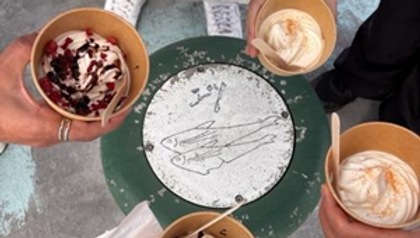This site is available in multiple languages. Please select your preferred language from the bar at the bottom right.
Craft Kyushu | A report from an international student living in Kyushu about the real experiences and excitement of traditional crafts

Shin Ju
A different Fukuoka: a city of arts and crafts

A different Fukuoka: A city of arts and crafts When people think of Okawa City, Fukuoka Prefecture, the first thing that comes to mind for many is the bustling city of Fukuoka.
With its delicious food, great shopping and entertainment options, it is the first choice for many tourists. But today, I would like to introduce you to another side of Fukuoka from a different perspective: Okawa City, a city brimming with arts and craftsmanship. When you step into Okawa City, the first thing that catches your eye is the spectacular iron bridge, the Chikugo River Lift Bridge. This bridge is designated as a "National Cultural Property," and according to locals, it was originally a railway bridge. At first glance, it looks like just another means of transportation, but it is distinctive for its unique structure that allows it to be raised, lowered and moved.
The center of the bridge rises vertically so as not to impede the passage of boats on the Chikugo River. This original design is extremely rare throughout Japan. Although it is no longer used as a railway bridge, it remains a landmark of Okawa City, conveying the wisdom of our ancestors to the present day.
As I reached the end of the bridge, I noticed a poster that read "Chikugo River Lift Bridge." At night, the bridge is lit up with lights and looks especially charming, like a dream blooming on the water. I sincerely hope that one day I will be able to watch the flowers blooming quietly at night.
Our first stop was a wonderful preview of the rest of our journey, a journey of structure, craftsmanship and architectural beauty.
Speaking of carpentry, where did this technique come from? It is said that in the old days, the craftsmen themselves would go deep into the mountains, carefully observe the trees, and select the appropriate ones. The selected timber would be cut down, float down the mountain stream, and be carried to the Okawa River, which joins the Chikugo River. This process was like a collaboration between humans and nature, and the "Great River" we know today was born.
Okawa City's buildings are not only made of steel and concrete, but are also built to give you a sense of the warmth of wood. The city is famous for its woodworking techniques, especially traditional wooden furniture and elaborate kumiko crafts. We actually experienced a woodworking journey, learned how to make a series of wood pieces, and tried the process of polishing and joining the pieces. Woodworking may seem easy, but it takes a craftsman's great skill and patience to make this material.
With friends. In the evening, we walked around the old streets of the Edo period and visited many shrines. We also visited an old house built over 200 years ago. Inside the house, beautiful old crafts were on display.
The next day, when we visited the Kumiko workshop, we were even more impressed by the extremely precise crafts that took months to create. The group lamps, the wooden screens, every line and every connection speak to the craftsman's inner focus and passion. This process usually takes one to three months to create, during which time extreme care is required to maintain the precision and beauty of each line. Although the craftsmen often hurt their fingers from long hours of manual labor, they say, "We don't make products, we make art that is an extension of our emotions and passion."

As I strolled around Okawa, I noticed that the city was also filled with an artistic atmosphere.

The streets are lined with old artworks that tell the stories and splendor of the past, including classic posters and paintings. An inconspicuous old stone pillar in a back alley is actually the remains of a horse tether, making you feel like you've traveled back in time to the days when horse riding was the main form of transportation.
The long-lasting aroma of vinegar: a taste journey
Food is an essential part of any trip. However, the most surprising thing about Okawa is its unique seasoning, rice vinegar. Thanks to the abundant water resources and fertile land of the Chikugo River Basin, high-quality rice is produced. Sake brewed from rice has evolved into a fruit vinegar with a delicate flavor and long aftertaste.
Not only did we taste a variety of fruit vinegar flavors, but we also went deep into a traditional brewery and witnessed the entire process of natural fermentation. In an age where we rely heavily on rapid industrial production, Okawa is committed to using time and nature to create a true "slow-brewed flavor." Upon entering the vinegar brewery, the sour and fragrant smell seems to tell us, "This is a unique flavor that has accumulated over the years, and it is the memory of the city."
Another very interesting fact is that chillies from Okawa are five times hotter than habaneros. We also tried the chilli ice cream, a unique combination of hot, spicy, sweet and cold. It shows the unique creativity of this city. The ice cream is a perfect blend of spicy and cool, a perfect fusion of opposing elements, almost like a work of art.
In Okawa, art is not intentionally displayed in museums, but lives in every corner of the city, in every handmade product, in every dish. Craftsmanship here is not only a reflection of technique, but also a lifestyle philosophy. This work expresses in the simplest, yet most moving way, what true "beauty" is: a not loud but deeply moving emotion, a quiet but enduring force.
This is another Fukuoka, Okawa City.
Report
Chinese (Simplified)






















